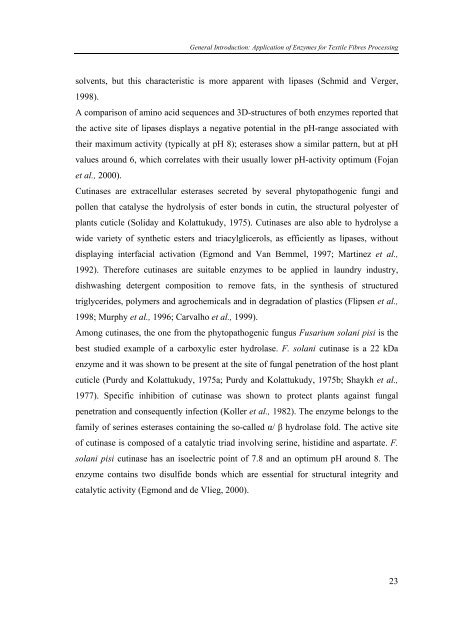Surface Modification of Cellulose Acetate with Cutinase and ...
Surface Modification of Cellulose Acetate with Cutinase and ...
Surface Modification of Cellulose Acetate with Cutinase and ...
You also want an ePaper? Increase the reach of your titles
YUMPU automatically turns print PDFs into web optimized ePapers that Google loves.
General Introduction: Application <strong>of</strong> Enzymes for Textile Fibres Processing<br />
solvents, but this characteristic is more apparent <strong>with</strong> lipases (Schmid <strong>and</strong> Verger,<br />
1998).<br />
A comparison <strong>of</strong> amino acid sequences <strong>and</strong> 3D-structures <strong>of</strong> both enzymes reported that<br />
the active site <strong>of</strong> lipases displays a negative potential in the pH-range associated <strong>with</strong><br />
their maximum activity (typically at pH 8); esterases show a similar pattern, but at pH<br />
values around 6, which correlates <strong>with</strong> their usually lower pH-activity optimum (Fojan<br />
et al., 2000).<br />
<strong>Cutinase</strong>s are extracellular esterases secreted by several phytopathogenic fungi <strong>and</strong><br />
pollen that catalyse the hydrolysis <strong>of</strong> ester bonds in cutin, the structural polyester <strong>of</strong><br />
plants cuticle (Soliday <strong>and</strong> Kolattukudy, 1975). <strong>Cutinase</strong>s are also able to hydrolyse a<br />
wide variety <strong>of</strong> synthetic esters <strong>and</strong> triacylglicerols, as efficiently as lipases, <strong>with</strong>out<br />
displaying interfacial activation (Egmond <strong>and</strong> Van Bemmel, 1997; Martinez et al.,<br />
1992). Therefore cutinases are suitable enzymes to be applied in laundry industry,<br />
dishwashing detergent composition to remove fats, in the synthesis <strong>of</strong> structured<br />
triglycerides, polymers <strong>and</strong> agrochemicals <strong>and</strong> in degradation <strong>of</strong> plastics (Flipsen et al.,<br />
1998; Murphy et al., 1996; Carvalho et al., 1999).<br />
Among cutinases, the one from the phytopathogenic fungus Fusarium solani pisi is the<br />
best studied example <strong>of</strong> a carboxylic ester hydrolase. F. solani cutinase is a 22 kDa<br />
enzyme <strong>and</strong> it was shown to be present at the site <strong>of</strong> fungal penetration <strong>of</strong> the host plant<br />
cuticle (Purdy <strong>and</strong> Kolattukudy, 1975a; Purdy <strong>and</strong> Kolattukudy, 1975b; Shaykh et al.,<br />
1977). Specific inhibition <strong>of</strong> cutinase was shown to protect plants against fungal<br />
penetration <strong>and</strong> consequently infection (Koller et al., 1982). The enzyme belongs to the<br />
family <strong>of</strong> serines esterases containing the so-called α/ β hydrolase fold. The active site<br />
<strong>of</strong> cutinase is composed <strong>of</strong> a catalytic triad involving serine, histidine <strong>and</strong> aspartate. F.<br />
solani pisi cutinase has an isoelectric point <strong>of</strong> 7.8 <strong>and</strong> an optimum pH around 8. The<br />
enzyme contains two disulfide bonds which are essential for structural integrity <strong>and</strong><br />
catalytic activity (Egmond <strong>and</strong> de Vlieg, 2000).<br />
23

















